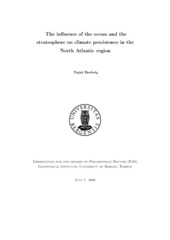The influence of the ocean and the stratosphere on climate persistence in the North Atlantic region
Doctoral thesis
Permanent lenke
https://hdl.handle.net/1956/3502Utgivelsesdato
2009-09-07Metadata
Vis full innførselSamlinger
- Geophysical Institute [1187]
Sammendrag
The North Atlantic Oscillation (NAO) is generally regarded to largely be a product of processes internal to the troposphere. This thesis investigates various aspects of how the NAO and related climatical fields are influenced by two of the tropospheric boundary components; the stratosphere above and the ocean below. The thesis consists of five manuscripts, three considering the role of the stratosphere, and two considering the role of the ocean. Data provided by the NCEP/NCAR re-analyses is used to investigate how anomalies in the stratospheric circulation relate to subsequent anomalies in various important climatic fields. The mean storm tracks are found to shift meridionally, although not symmetrically between the Pacific and the Atlantic regions (paper I). Following events of anomalously weak stratospheric circulation, a statistically significant shift in the storm track is found only over the Atlantic. The spatial temperature distribution is found to go through several spatially and temporally distinct stages (paper II). In key regions, including northern Asia, Europe and the oceanic areas off the east coast of North America, the probability of cold air outbreaks increases by 50 – 80% at various stages relative to the negative stratospheric circulation anomaly peak. The strongest cold air outbreak appears in Northern Asia several weeks before the stratospheric anomaly peaks. This cooling is associated with cold, northwesterly winds due to a strong high pressure anomaly centered above Northern Scandinavia. In a separate study (paper III), it is shown that this high pressure anomaly is a typical precursor of negative stratospheric circulation anomalies. It is found that it is associated with enhanced vertical wave propagation – which is known to favour negative stratospheric circulation anomalies. When the Scandinavian high precedes negative stratospheric circulation anomalies, the stratospheric anomalies become more intense, and stronger subsequent surface climate signals arise compared to events without a preceding Scandinavian high. The oceanic influence on the NAO is investigated by using both re-analysed and modeled data. The feedback by North Atlantic Sea Surface Temperatures (SSTs) on the NAO is quantified by applying lagged regression models on daily, re-analysed data (paper IV). It is found that interactions between the SSTs and the NAO on daily time scale provide predictive information about the NAO in excess of what is provided by the NAO alone. SSTs along the coast of Northern America, coinciding partly with the Gulf Stream, are especially important, and are in particular found to help account for decadal NAO variability. The Gulf Stream SSTs are found to provide more prediction skill to the NAO than the well-known SST Tripole is able to. The relation between a continuously weakening Atlantic meridional overturning circulation and interannual variability in the NAO is investigated by using data produced by the Bergen Climate Model (BCM) (paper V). It is found that the NAO develops a pronounced biennial cycle in the phase of a continuously weakening overturning circulation. A corresponding biennial signal is found also in El Niño-Southern Oscillation (ENSO). Although several hypotheses are tested, the exact processes involved in the NAO and ENSO responses are yet to be disclosed.
Består av
Paper I: Geophysical Research Letters 35, Breiteig, T., Extra-tropical synoptic cyclones and downward propagating anomalies in the Northern Annular Mode, L07809. Copyright 2008 The American Geophysical Union. Full text not available in BORA due to publisher restrictions. The published version is available at: http://dx.doi.org/10.1029/2007GL032972Paper II: Kolstad, E. W.; Breiteig, T.; Scaife, A. A., 2009, The association between stratospheric weak polar vortex events and cold air outbreaks. Full text not available in BORA.
Paper III: Breiteig, T., 2009, Tropospheric precursors of downward propagating anomalies in the Northern Annular Mode. Full text not available in BORA.
Paper IV: Breiteig, T.; Stephenson, D. B.; Kvamstø, N. G., 2009, Local interactions between the North Atlantic Ocean and the NAO. Full text not available in BORA.
Paper V: Breiteig, T., 2009, The association between a weakening AMOC and the ENSO and NAO interannual variability. Full text not available in BORA.
